Education/Teaching of Individuals in Junior High/Middle School Special Education Programs
Types of Degrees Education/Teaching of Individuals in Junior High/Middle School Special Education Programs Majors Are Getting
The following table lists how many education/teaching of individuals in junior high/middle school special education programs graduations there were for each degree level during the last year for which data was available.
| Education Level | Number of Grads |
|---|---|
| Master’s Degree | 57 |
| Bachelor’s Degree | 22 |
What Education/Teaching of Individuals in Junior High/Middle School Special Education Programs Majors Need to Know
In an O*NET survey, education/teaching of individuals in junior high/middle school special education programs majors were asked to rate what knowledge areas, skills, and abilities were important in their occupations. These answers were weighted on a scale of 1 to 5 with 5 being the most important.
Knowledge Areas for Education/Teaching of Individuals in Junior High/Middle School Special Education Programs Majors
According to O*NET survey takers, a major in education/teaching of individuals in junior high/middle school special education programs should prepare you for careers in which you will need to be knowledgeable in the following areas:
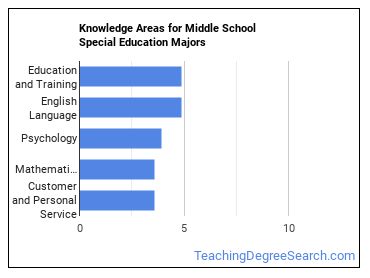
- Education and Training - Knowledge of principles and methods for curriculum and training design, teaching and instruction for individuals and groups, and the measurement of training effects.
- English Language - Knowledge of the structure and content of the English language including the meaning and spelling of words, rules of composition, and grammar.
- Psychology - Knowledge of human behavior and performance; individual differences in ability, personality, and interests; learning and motivation; psychological research methods; and the assessment and treatment of behavioral and affective disorders.
- Mathematics - Knowledge of arithmetic, algebra, geometry, calculus, statistics, and their applications.
- Customer and Personal Service - Knowledge of principles and processes for providing customer and personal services. This includes customer needs assessment, meeting quality standards for services, and evaluation of customer satisfaction.
Skills for Education/Teaching of Individuals in Junior High/Middle School Special Education Programs Majors
education/teaching of individuals in junior high/middle school special education programs majors are found most commonly in careers in which the following skills are important:
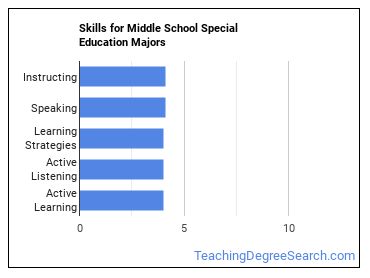
- Speaking - Talking to others to convey information effectively.
- Instructing - Teaching others how to do something.
- Active Listening - Giving full attention to what other people are saying, taking time to understand the points being made, asking questions as appropriate, and not interrupting at inappropriate times.
- Active Learning - Understanding the implications of new information for both current and future problem-solving and decision-making.
- Learning Strategies - Selecting and using training/instructional methods and procedures appropriate for the situation when learning or teaching new things.
Abilities for Education/Teaching of Individuals in Junior High/Middle School Special Education Programs Majors
As a education/teaching of individuals in junior high/middle school special education programs major, you will find yourself needing the following abilities:
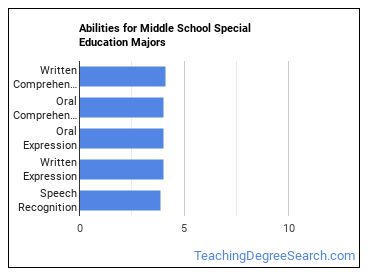
- Written Comprehension - The ability to read and understand information and ideas presented in writing.
- Oral Comprehension - The ability to listen to and understand information and ideas presented through spoken words and sentences.
- Oral Expression - The ability to communicate information and ideas in speaking so others will understand.
- Written Expression - The ability to communicate information and ideas in writing so others will understand.
- Problem Sensitivity - The ability to tell when something is wrong or is likely to go wrong. It does not involve solving the problem, only recognizing there is a problem.
What Can You Do With a Education/Teaching of Individuals in Junior High/Middle School Special Education Programs Major?
People with a education/teaching of individuals in junior high/middle school special education programs degree often go into the following careers:
| Job Title | Job Growth Rate | Median Salary |
|---|---|---|
| Special Education Teachers, Middle School | 7.2% | $60,250 |
Who Is Getting a Bachelor’s Degree in Education/Teaching of Individuals in Junior High/Middle School Special Education Programs?
Racial-Ethnic Diversity
At the countrywide level, the racial-ethnic distribution of education/teaching of individuals in junior high/middle school special education programs majors is as follows:
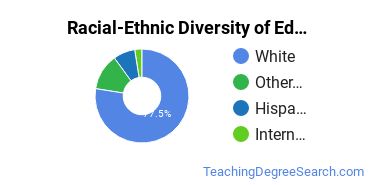
| Race/Ethnicity | Number of Grads |
|---|---|
| Asian | 1 |
| Black or African American | 0 |
| Hispanic or Latino | 3 |
| White | 17 |
| International Students | 1 |
| Other Races/Ethnicities | 0 |
Geographic Diversity
Americans aren’t the only ones with an interest in Education/Teaching of Individuals in Junior High/Middle School Special Education Programs. About 4.5% of those with this major are international students.
Amount of Education Required for Careers Related to Education/Teaching of Individuals in Junior High/Middle School Special Education Programs
Some degrees associated with education/teaching of individuals in junior high/middle school special education programs may require an advanced degree, while others may not even require a bachelor’s in the field. In general, the more advanced your degree the more career options will open up to you. However, there is significant time and money that needs to be invested into your education so weigh the pros and cons.
Find out what the typical degree level is for education/teaching of individuals in junior high/middle school special education programs careers below.
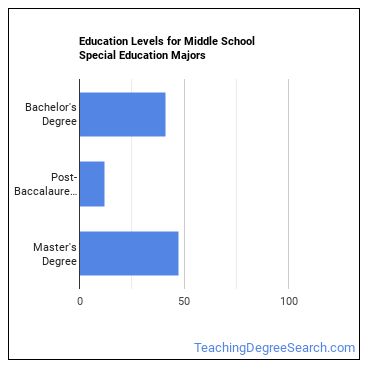
| Education Level | Percentage of Workers |
|---|---|
| Bachelor’s Degree | 41.2% |
| Post-Baccalaureate Certificate - awarded for completion of an organized program of study; designed for people who have completed a Baccalaureate degree but do not meet the requirements of academic degrees carrying the title of Master. | 12.2% |
| Master’s Degree | 47.3% |
Online Education/Teaching of Individuals in Junior High/Middle School Special Education Programs Programs
The following table lists the number of programs by degree level, along with how many schools offered online courses in the field.
| Degree Level | Colleges Offering Programs | Colleges Offering Online Classes |
|---|---|---|
| Certificate (Less Than 1 Year) | 0 | 0 |
| Certificate (1-2 years) | 0 | 0 |
| Certificate (2-4 Years) | 0 | 0 |
| Associate’s Degree | 0 | 0 |
| Bachelor’s Degree | 1 | 0 |
| Post-Baccalaureate | 0 | 0 |
| Master’s Degree | 8 | 0 |
| Post-Master’s | 0 | 0 |
| Doctor’s Degree (Research) | 0 | 0 |
| Doctor’s Degree (Professional Practice) | 0 | 0 |
| Doctor’s Degree (Other) | 0 | 0 |
Explore Major by State
Alabama
California
District of Columbia
Idaho
Kansas
Maryland
Mississippi
Nevada
New York
Oklahoma
South Carolina
Utah
West Virginia
Alaska
Colorado
Florida
Illinois
Kentucky
Massachusetts
Missouri
New Hampshire
North Carolina
Oregon
South Dakota
Vermont
Wisconsin
Majors Related to Education/Teaching of Individuals in Junior High/Middle School Special Education Programs
You may also be interested in one of the following majors related to education/teaching of individuals in junior high/middle school special education programs.
References
*The racial-ethnic minorities count is calculated by taking the total number of students and subtracting white students, international students, and students whose race/ethnicity was unknown. This number is then divided by the total number of students at the school to obtain the racial-ethnic minorities percentage.
- College Factual
- College Scorecard
- National Center for Education Statistics
- O*NET Online
- U.S. Bureau of Labor Statistics
- Usual Weekly Earnings of Wage and Salary Workers First Quarter 2020
- Image Credit: By woodleywonderworks under License
More about our data sources and methodologies.
